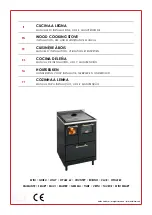
21
If there is an extraction fan fitted in adjacent rooms where this appliance is fitted, additional air
vents may be required to alleviate the possibility of spillage of products of combustion from the
appliance/flue while the fan is in operation. Refer to B.S. 8303 Part 1. Where such an installation
exists, a test for spillage
must
be made with the fan or fans and other appliances using air in
operation at full rate, (i.e., extraction fans, tumble dryers) with interconnecting doors fully open.
and all external doors and windows closed. If spillage occurs following the above operation, an
additional air vent of sufficient size to prevent this occurrence
must be
installed.
This stove requires an adequate air supply for the stove to operate safely and efficiently. The
installer may have fitted a permanent air supply vent into the room in which the stove is installed
to provide combustion and / or ventilation air. This air vent should not under any circumstances
be shut off or sealed.
3.6
Chimney Draft conditions
If smoke spillage occurs when the fire door is opened, it is probably due to poor chimney draft. This
type of stove requires at least
12 pa
of chimney draft to achieve satisfactory combustion and smoke
spillage prevention. However, in cases where the stove door is opened too vigorously you could
expect that slight smoke spillage may occur.
If the flue draft is too high then this can create run away combustion making the stove difficult to
control and cause damage to the stove by over firing.
If you have any doubts, you may want to have your installer measure the draft in the chimney.
Draft conditions
The chimney’s draft is the resulting effect within the flue caused by the difference in temperature
within the flue and the cooler temperature outside, plus the outside air flow across the top of the
chimney pot exit, factors that can influence the level of draft include the length of the flue,
insulation of the chimney, adverse weather conditions or tall buildings or trees nearby the flue
terminal.
Poor draft occurs when:
The atmospheric temperature difference is too low.
The outside temperature is too high, e.g., during the summer months.
There is no air movement (wind) outside.
The chimney is not tall enough, with the result that the terminal sits in the lee of the roof surface
or in the vicinity of tall trees or neighboring buildings. These conditions are also associated with
downdraft where the flue gases are pushed back down the chimney.
Flue draft is diluted by residual air entering the chimney, e.g., due to inadequate fluepipe joints
or leaks at the cleaning door or flue collar.
Unsealed, unused fireplaces are connected to the chimney.
The flue is blocked, e.g., by soot, due to inadequate cleaning, loose debris or even a bird’s nest.
The room to which the stove is installed is too tightly sealed. (See section on Fresh air supply).
A good draft is achieved when:
The temperature difference between the flue way or chimney and outside atmosphere is high.
(Higher temperature in flue way or chimney and cooler temperature to external atmosphere).
This also applies during firing when the need is greatest.
The weather is clear and there is a good wind.
The chimney is of the correct height.
The room that the stove is installed is adequately ventilated.
















































